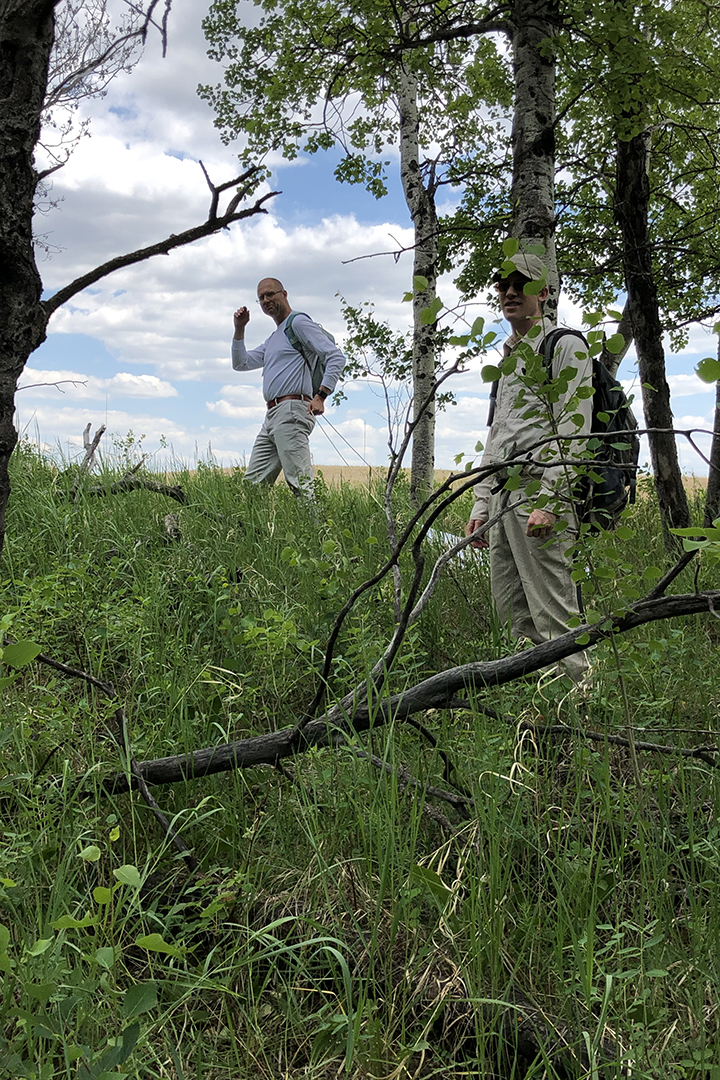
Ecologist’s work targets what makes Lyme disease tick
Dr. Maarten Voordouw and his wife Anne enjoy being outdoors, especially with their young daughters, Naia and Margot. But after any outing, particularly if the girls have been playing in the grass or leaves, the couple are diligent about checking for ticks.
By Lynne Gunville“Ticks take their time to find a place to bite, so if you inspect yourself and your kids carefully, you can find them,” says Voordouw, an assistant professor at the Western College of Veterinary Medicine (WCVM).
“As yet, the ticks that transmit Lyme disease are not established in Saskatchewan, but even if one bites, it takes about 12 to 24 hours for the bacterium to be transmitted. You can protect yourself against this disease, but if you’ve been in the outdoors, you need to be disciplined and come back and check.”
It’s sound advice from someone who has spent the past 10 years researching the ecology of Lyme disease – the most common vector-borne disease in North America.
Over the past 15 years, there has been a dramatic increase in Lyme disease in Canada with surveillance by the Government of Canada indicating that the tick species responsible for transmitting Lyme disease has greatly increased its geographic range and abundance in the country. The most likely explanation is climate change; a warmer climate is allowing the tick to settle in parts of Canada that were previously too cold. And once the tick sets up shop, the bacterium is quick to follow.
Uptick in Lyme disease cases

About 600 to 800 people are infected annually in Canada where Lyme disease is a nationally notifiable disease. In the United States, the Centers for Disease Control and Prevention (CDC) report about 30,000 human cases each year. However, the CDC experts recently suggested that the actual case numbers in the U.S. could be 10 times higher than their official count — mainly because physicians are not reporting every diagnosed human case in regions where the disease is very common (endemic).
Voordouw is now charged with establishing a research group in the WCVM’s Department of Veterinary Microbiology that will study ticks and tick-borne diseases in Canada.
His work in this area began at the University of Pennsylvania in Philadelphia where he completed a postdoctoral fellowship that focused exclusively on Lyme disease. That valuable experience provided the skills and knowledge Voordouw needed to qualify for an assistant professorship at the University of Neuchâtel in the French part of Switzerland.
Voordouw spent seven years at the Swiss university where he established a research program that examined various aspects of Lyme disease ecology and resulted in the publication of over 30 scientific papers. He particularly enjoyed working with the graduate students and seeing their success.
“Working with young people, seeing their enthusiasm and really working collectively as a team – that was really amazing,” says Voordouw. “Their projects were interesting and worthwhile and made a contribution to the scientific community, and so it was really exciting and rewarding to be a part of that.”
Diversity of disease-causing bacteria
Much of the research lab’s work was directed at the bacteria that cause Lyme disease; scientists have discovered that a number of different bacterial species cause this condition in humans. Those species include Borrelia burgdorferi, which is found in North America and Europe, as well as B. afzelii and B. garinii, which are found only in Europe.
In turn, each species of Borrelia can consist of many different strains that co-exist in the same local ecosystem. Voordouw and his team were particularly interested in studying this diversity of strains within a Borrelia species.
While investigating the tick population in a soccer-sized patch of forest in Switzerland, the researchers were able to detect a dozen different strains of Borrelia with some strains more common than others — a discovery that prompted even more questions for the scientists.
They also found that 80 per cent of the ticks carried two or more strains. This finding is significant since it indicates that a tick bite exposes a host such as a mouse or a human to multiple strains of the bacterium.
The research team also conducted infection experiments in the lab – an opportunity for them to observe and compare the transmission success of the different strains.
Voordouw points out that vector-borne diseases like Lyme disease are complex and difficult to study because there are so many different parts.
“To understand the ecology of Lyme disease, you have to study three different organisms: the bacterial pathogen, the tick vector and the animal host, of which there are many. You have to know the factors that are driving the ecology and abundance of ticks and the factors that are driving the ecology and abundance of the reservoir hosts that are mostly rodents and birds.”
Since the human caseload depends on the exposure of humans to ticks, scientists must consider human abundance and behaviour – factors such as the time spent outdoors in the woods, the awareness of ticks, and the motivation to use preventive methods such as wearing appropriate clothing, using acaricides and checking for ticks after a walk through the woods.
Tackling the problem of Lyme disease
While Voordouw enjoyed his work in Switzerland, he’s happy to be back in North America setting up a similar research program at the WCVM. He’s also excited to be working at a veterinary college where he’ll have the opportunity to collaborate with and learn from other faculty whose expertise can greatly benefit his research.
Now that he and his research team have secured funding from the Saskatchewan Health Research Foundation and the Natural Sciences and Engineering Research Council of Canada (NSERC), they’re ready to begin their investigations on the Canadian strains of B. burgdorferi.
In addition to learning more about the multiple strains, the scientists will study their interactions with each other as well as with their tick vectors and vertebrate hosts.
Voordouw says he and his colleagues have many questions to answer: why are some strains of B. burgdorferi more common than other strains in nature? Are the common strains more successful at transmission than the rare strains? When ticks or hosts are infected with multiple strains of B. burgdorferi, do the strains compete or do they co-operate with each other?
The researchers will also examine the role of the host immune system in maintaining strain diversity. Previous research indicates that the vertebrate host can develop highly specific antibodies that protect against re-infection with a particular strain but provide no protection from others. That’s why some unfortunate individuals get Lyme disease multiple times over their lifetime, with each new infection resulting from a different strain of the bacterium.
A better understanding of the strain diversity of this bacterium will help to solve the problem of Lyme disease. For example, information about the bacterial strains can be helpful for tweaking or even developing new diagnostic tests capable of detecting the diverse strains of B. burgdorferi found in Western Canada.
Voordouw looks forward to the research as well as the opportunity to establish a life for his family in Saskatoon. He and his wife have just purchased a house and they’re happy to live closer to their extended families.
“I’m really excited to be part of the University of Saskatchewan and to be able to make a contribution to the Canadian research community,” says Voordouw. “I know that a lot of people are concerned about Lyme disease. It’s an important problem, and I’m excited to be part of the dialogue that surrounds this issue.”
Lynne Gunville of Candle Lake, Sask., is a freelance writer and editor whose career includes 25 years of teaching English and communications to adults.
